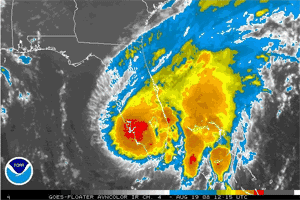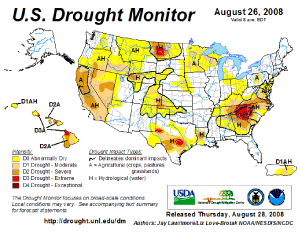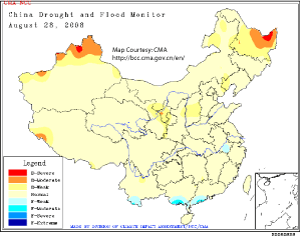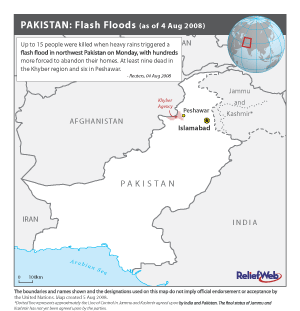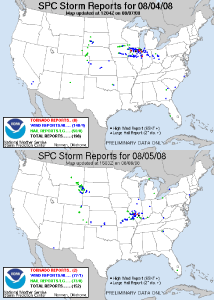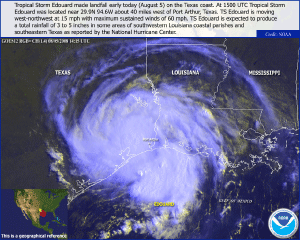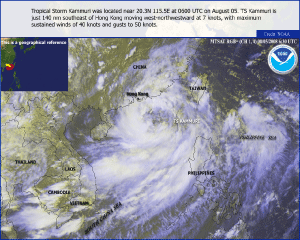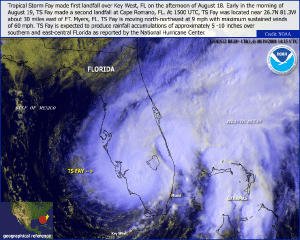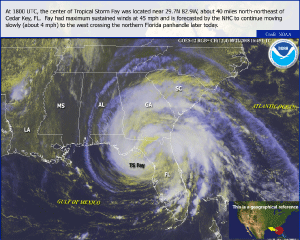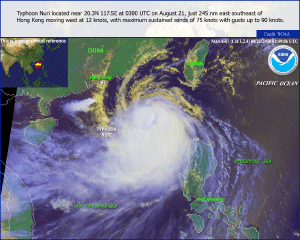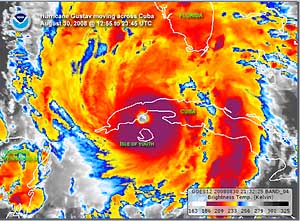
Global Hazards and Significant Events
August 2008
Tropical Storm Fay brought copious amounts of rain to the drought-stricken southeast. Fay became the first storm in recorded history to hit a state (Florida) four different times. Additional information can be found below.

Moderate to extreme drought conditions persisted across parts of the Hawaiian Islands and the central and southeastern parts of the continental U.S. during the last week of August. Exceptional drought continued across South Carolina. The southern High Plains saw a slight improvement in drought conditions, dropping from extreme to severe (compared to the 12 August 2008 USDM map). As of August 26, 30% of the western U.S., 22% of the South, 16% of the High Plains, 45% of the Southeast, and 23% of the contiguous U.S. were in moderate to exceptional drought, according to the U.S. Drought Monitor. For a complete drought analysis across the United States, please see the U.S. drought page.
As of August 28, China had moderate to severe drought conditions across parts of Heilongjiang and northern Xinjiang provinces (Beijing Climate Center).
A heat wave affected parts of the U.S. from mid-July through early August. In Denver, CO, temperatures were above 32°C (90°F) for 24 consecutive days (as of August 5), breaking the previous record set in both 1874 and 1901 with 18 consecutive days (NWS).

In China, torrential rain fell across parts of the Anhui and Jiangsu provinces from July 31-August 1, prompting dangerous floods which forced more than 76,000 people to evacuate the area. According to reports, parts of the city of Chuzhou was under half a meter (20 inches) of water. Two fatalities were reported in the Anhui province, and the economic losses were estimated to be 220 million U.S. dollars. The floods also destroyed more than 24,000 houses (AFP).
Heavy monsoonal rain fell across northwestern Pakistan during the first week of August. The floods affected 82,000 people, destroyed more than 3,200 homes, and were responsible for 27 fatalities (Associated Press).
In Togo, heavy rainfall produced deadly floods during the first week of August. Nine fatalities were associated with the floods, which also affected nearly 5,000 people (Associated Press).
Intense monsoonal rains pounded southern India from August 7-9. The heavy downpours claimed the lives of 59 people and another 40 were feared dead when the truck they were riding on was swept away by a flooded river (Associated Press). Intense monsoonal downpours pummeled northern India, claiming the lives of 74 people, leaving 50,000 people homeless (Reuters), and triggering the collapse of several buildings. Varanasi, one of the hardest hit cities, received a total of 292.1 mm (11.5 inches) of rain in 24 hours (Associated Press). Meanwhile, in the State of Assam, floodwaters submerged about 100 villages, forcing thousands of residents to evacuate the area. In neighboring Nepal, the heavy rainfall caused the Kosi river to spill over its banks, flooding villages and leaving several people missing (Associated Press).
In Laos, heavy rainfall triggered fatal floods and landslides that claimed the lives of 4 people (Reuters/BBC News). In Vientiane, the copious rains caused the Mekong River to reach 13.68 m (44.88 ft) on August 14, surpassing the previous record high of 12.38 m (40.61 ft) set in 1966 (Reuters). According to reports, this was the worst flooding in living memory (BBC News).
In Scotland, torrential rainfall brought flooding across the city of Dundee on August 21. It was reported that the city was inundated by 1.2 m (4 ft) of water. According to reports, this was the worst flooding the city has experienced (BBC News).
On the night of August 25, heavy rain fell in Mexico City. The downpours triggered floods and mudslides that affected a horse club. Fifty horses drowned and one person died while trying to save the animals (Associated Press).
In parts of central Japan, torrential rain fell on August 29. The heavy rainfall caused floods and landslides, forcing nearly half a million people to evacuate the area. According to reports, the city of Okazaki received 145 mm (5.7 inches) of rain in one hour. One fatality was reported (BBC News).

Severe storms in northern France spawned a tornado, which collapsed several homes and uprooted trees. The tornado was blamed for the deaths of three people and for leaving 13 others injured (Associated Press).
In the United States, severe storms ripped through parts of Illinois and Indiana from August 4-5, producing 10 preliminary tornado reports, damaging winds, and hail. The storms damaged 25 homes, prompted the cancellation of more than 350 flights at O'Hare International Airport, left nearly 288,000 residents without power, and were blamed for the deaths of two people (Associated Press/Reuters).

Tropical Storm Edouard developed as a tropical depression in northern Gulf of Mexico on August 3. The storm strengthened to a tropical storm later that same day, but reached its peak intensity of 104 km/hr (65 mph or 56 knots) before it made landfall along the upper Texas coast, east of Galveston, on the 5th. The storm brought much-needed precipitation to parts of Texas. Edouard weakened as it moved further inland. No fatalities were reported.
Tropical Storm Kammuri developed as a tropical depression in the South China Sea on August 4. Later that same day, the depression strengthened to a tropical storm. The strongest winds Kammuri produced were 93 km/hr (57 mph or 50 knots), prior to making landfall in southern China on the 6th. The storm brought torrential rain to parts of Hong Kong, causing the disruption of air and road traffic and forcing the closure of stock markets (Xinhua). No fatalities were reported. Kammuri began to weaken as it continued its course towards northern Vietnam. The storm's remnants generated heavy downpours that triggered deadly flash floods and landslides in mountainous regions in northern Vietnam on August 9-11. It was reported thatriver water in the Yen Bai province were near the record level set in 1968 (Reuters). Over 300 homes were destroyed, more than 4,200 buildings were flooded, and nearly 8,700 hectares (21,500 acres) of crops were washed out (AFP/Reuters). According to reports, 120 fatalities were reported, with 44 others missing. The worst hit area was the Lao Cai province, where 36 people died and 38 others were missing. It was reported that 3 out of the 11 affected provinces have preliminary estimates of 105 million U.S. dollars in total property losses (Reuters).
Tropical Storm Fay developed over the Dominican Republic on August 15. The storm brought 72 km/hr (45 mph or 39 knots) winds and heavy rains across the island of Hispaniola. In the Dominican Republic, Fay downed trees and power lines, damaged hundreds of homes, and was blamed for killing 5 people who were swept away by flood waters. In Haiti, a bus was swept away by a flooded river, causing the deaths of 7 people and leaving 3 others missing (Associated Press). Fay exited the Island of Hispaniola and tracked toward Cuba, where authorities had already evacuated residents from low-lying areas. However, heavy downpours associated with Tropical Storm Fay caused floods across parts of Jamaica, resulting in two deaths (Reuters). The storm made landfall in western Cuba on August 17, with maximum sustained winds near 80 km/hr (49 mph or 43 knots). No fatalities were reported for Cuba (Associated Press/AFP). In total, Fay was blamed for 23 fatalities across the Caribbean. The storm was expected to become a hurricane after exiting Cuba into open waters; however, it remained a dangerous tropical storm. Fay made its first landfall in Florida, over Key West, on the 18th with maximum sustained winds near 97 km/hr (60 mph or 52 knots) (CNN), and then again south of Naples on the 19th.
The storm dumped copious amounts of rain across parts of Florida and spawned several tornadoes. It was reported that Fay downed trees, flooded streets, and left more than 93,000 residents without power (CNN). The storm moved toward the northeast, exiting the Florida panhandle near Melbourne on August 20. Nonetheless, Fay made its third landfall in Florida near Daytona Beach on August 21, tracking westward. The storm made its fourth and final landfall in Florida on the 23rd when it re-entered the state near Panama City, becoming the first storm in recorded history to strike the state (or any state) four concurrent times (Associated Press). As the storm zig-zagged across Florida, Fay hammered parts of the state with heavy rainfall. It was reported that Melbourne received more than 660 mm (26 inches) of rain and damages were estimated to be up to $12 million. The damage left by the storm across the state led President Bush to declare a state of emergency (CNN). Fay weakened into a depression as it drifted across the Gulf Coast states. Nevertheless, remnants of the storm caused heavy rain and widespread flooding across the drought-stricken Southeast. According to reports, Fay was responsible for 13 fatalities in the U.S.
Typhoon Nuri developed as a tropical depression in the northwestern Pacific Ocean on the 18th, reaching typhoon status the same day. The storm reached its peak intensity on August 19 with maximum sustained winds near 176 km/hr (109 mph or 95 knots). On August 20, Nuri made landfall in the northeastern tip of the Cagayan province, located in northern Luzon, in the Philippines Islands. The storm battered the region with maximum sustained winds near 140 km/hr (87 mph or 76 knots) and heavy rain. This triggered deadly landslides and floods that killed 7 people (Associated Press). Nuri tracked towards southeastern China and made landfall in Hong Kong on August 22. According to reports, Nuri was the worst typhoon to hit Hong Kong in 5 years (Reuters). As it moved towards the Guangdong province in southeastern China, the typhoon weakened to a tropical storm. Three fatalities were reported (AFP).
Hurricane Gustav developed as a tropical depression in the Caribbean Sea, south of the island of Hispaniola, on August 25. The following day the storm rapidly intensified into a tropical storm, then a category one hurricane, and made landfall in Haiti later that day, near the city of Jacmel, only a week after Tropical Storm Fay claimed 23 lives across the Caribbean. Gustav lashed Haiti with maximum sustained winds near 148 km/hr (92 mph or 80 knots) and torrential rain, prompting deadly floods and landslides. The storm was responsible for at least 59 fatalities in Haiti and 8 in neighboring Dominican Republic (Reuters) and for damaging nearly 900 homes (CNN). The storm weakened into a tropical storm as it exited Haiti. Gustav unexpectedly tracked south toward Jamaica, lashing the island on August 28 with maximum sustained winds near 112 km/hr (70 mph or 60 knots) and pounding rains (CNN). Gustav prompted flash floods that affected about 1,500 people and claimed the lives of 11 people (AFP). On August 30, Gustav made landfall in western Cuba as a category 4 hurricane with maximum sustained winds near 240 km/hr (150 mph or 130 knots). The storm caused major flooding, damaged crops, ripped roofs off houses, uprooted trees, and disrupted power and phone services. However, no fatalities where reported (BBC News). It was reported that Gustav was the worst storm to hit Cuba in 50 years. In the city of Paso Real de San Diego, 341 km/hr (212 mph or 184 knots) wind gusts were registered, the highest in Cuba's history (Miami Herald). By August 31, the storm moved across the Gulf of Mexico towards the U.S. Please see September's Global Hazards page for more information on Gustav.
For 2008 basin tropical cyclone statistics, please refer to the following:
Australian Basin
North Indian Ocean Basin
Western North Pacific Basin
South Pacific Basin
South Indian Ocean Basin
Northeast Pacific Ocean Basin
Atlantic Basin

No reports of significant extratropical cyclones were received during August 2008.

No reports of significant winter weather were received during August 2008.
 NOAA's National Centers for Environmental Information
NOAA's National Centers for Environmental Information
